Organizational Strategies of Flight Centre in Global Business
VerifiedAdded on 2022/11/25
|12
|2763
|115
AI Summary
The aim of this report is to discuss about the organizational strategies being followed by Flight centre in their global business. In doing so, it is identified that they are mainly following business growth strategies and cost leadership approaches. In addition, different business functions of Flight centre are also discussed and analyzed and identified majority of them are effective enough in maintaining the market leadership status of Flight centre. However, a few limitations are also identified and based on that, a few recommended steps are discussed. Implementation of these steps can help Flight centre in gaining the long term business viability.
Contribute Materials
Your contribution can guide someone’s learning journey. Share your
documents today.
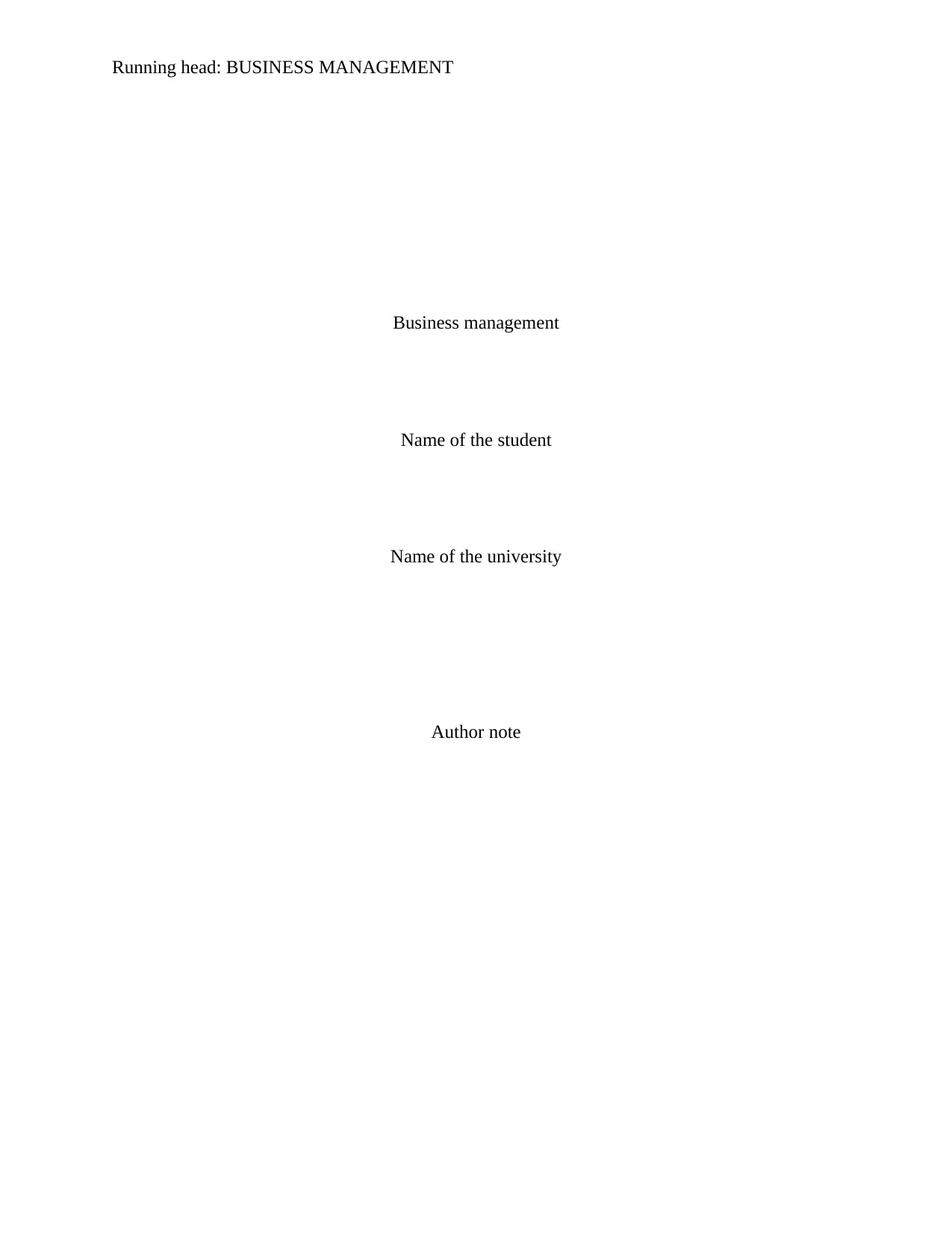
Running head: BUSINESS MANAGEMENT
Business management
Name of the student
Name of the university
Author note
Business management
Name of the student
Name of the university
Author note
Secure Best Marks with AI Grader
Need help grading? Try our AI Grader for instant feedback on your assignments.
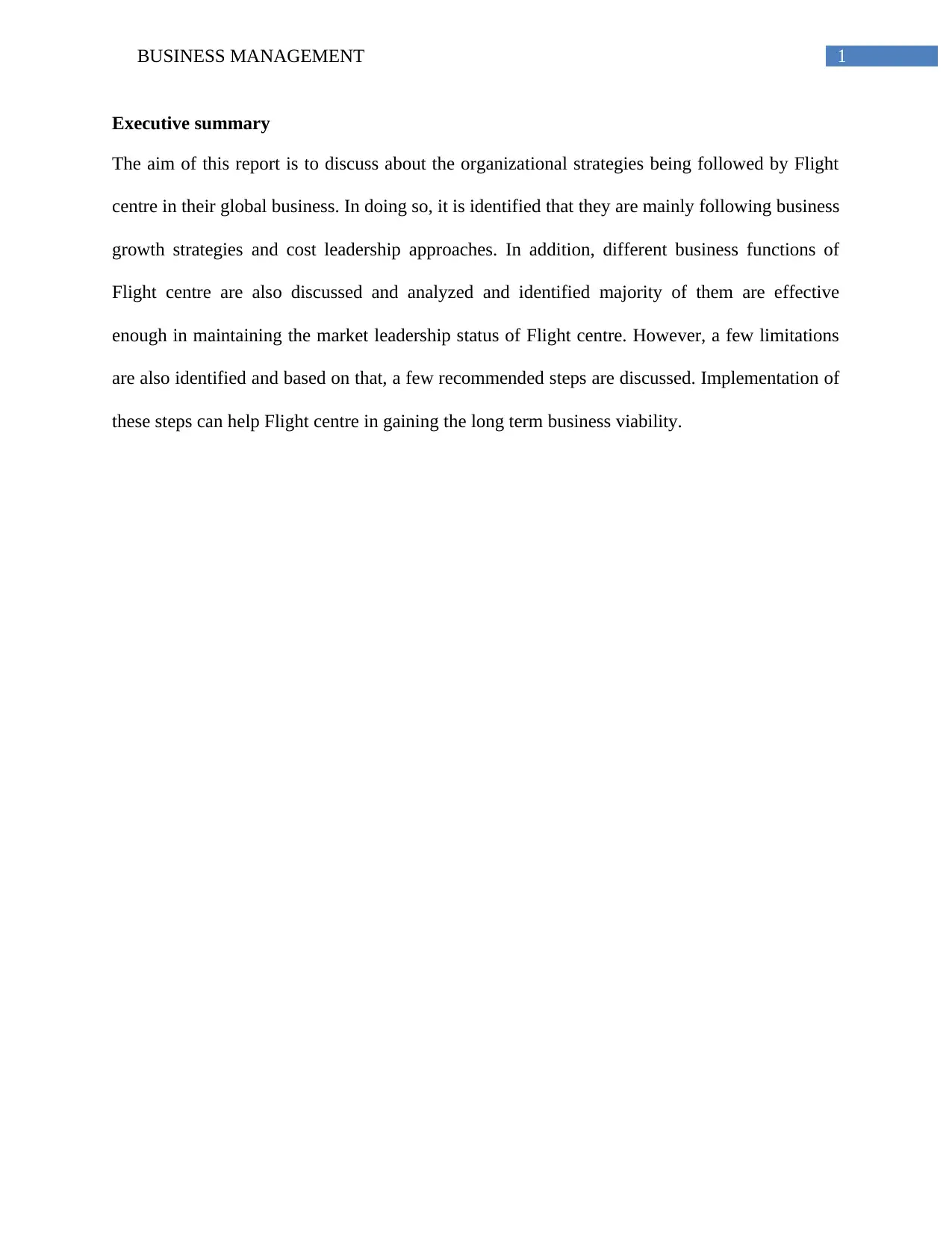
1BUSINESS MANAGEMENT
Executive summary
The aim of this report is to discuss about the organizational strategies being followed by Flight
centre in their global business. In doing so, it is identified that they are mainly following business
growth strategies and cost leadership approaches. In addition, different business functions of
Flight centre are also discussed and analyzed and identified majority of them are effective
enough in maintaining the market leadership status of Flight centre. However, a few limitations
are also identified and based on that, a few recommended steps are discussed. Implementation of
these steps can help Flight centre in gaining the long term business viability.
Executive summary
The aim of this report is to discuss about the organizational strategies being followed by Flight
centre in their global business. In doing so, it is identified that they are mainly following business
growth strategies and cost leadership approaches. In addition, different business functions of
Flight centre are also discussed and analyzed and identified majority of them are effective
enough in maintaining the market leadership status of Flight centre. However, a few limitations
are also identified and based on that, a few recommended steps are discussed. Implementation of
these steps can help Flight centre in gaining the long term business viability.
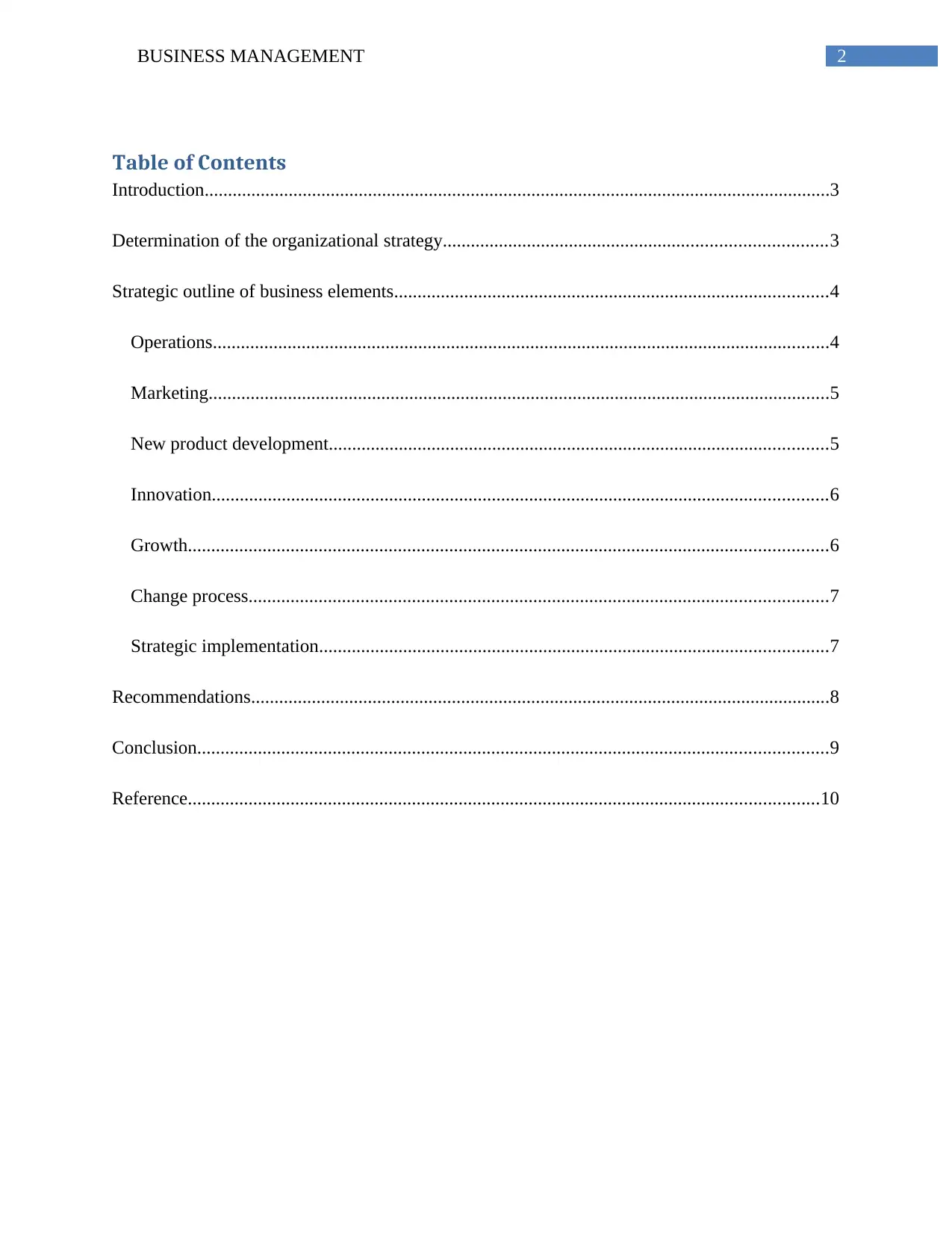
2BUSINESS MANAGEMENT
Table of Contents
Introduction......................................................................................................................................3
Determination of the organizational strategy..................................................................................3
Strategic outline of business elements.............................................................................................4
Operations....................................................................................................................................4
Marketing.....................................................................................................................................5
New product development...........................................................................................................5
Innovation....................................................................................................................................6
Growth.........................................................................................................................................6
Change process............................................................................................................................7
Strategic implementation.............................................................................................................7
Recommendations............................................................................................................................8
Conclusion.......................................................................................................................................9
Reference.......................................................................................................................................10
Table of Contents
Introduction......................................................................................................................................3
Determination of the organizational strategy..................................................................................3
Strategic outline of business elements.............................................................................................4
Operations....................................................................................................................................4
Marketing.....................................................................................................................................5
New product development...........................................................................................................5
Innovation....................................................................................................................................6
Growth.........................................................................................................................................6
Change process............................................................................................................................7
Strategic implementation.............................................................................................................7
Recommendations............................................................................................................................8
Conclusion.......................................................................................................................................9
Reference.......................................................................................................................................10
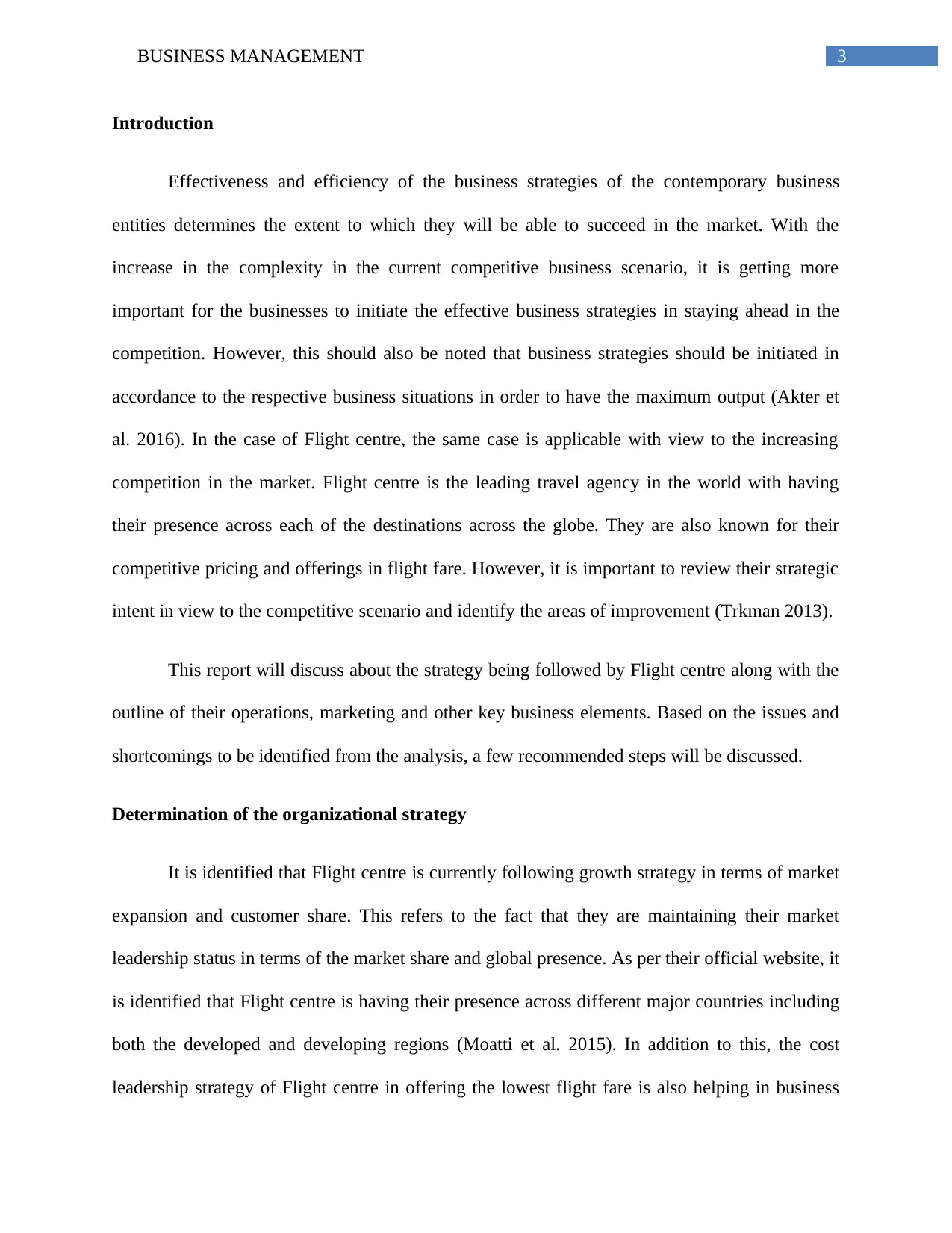
3BUSINESS MANAGEMENT
Introduction
Effectiveness and efficiency of the business strategies of the contemporary business
entities determines the extent to which they will be able to succeed in the market. With the
increase in the complexity in the current competitive business scenario, it is getting more
important for the businesses to initiate the effective business strategies in staying ahead in the
competition. However, this should also be noted that business strategies should be initiated in
accordance to the respective business situations in order to have the maximum output (Akter et
al. 2016). In the case of Flight centre, the same case is applicable with view to the increasing
competition in the market. Flight centre is the leading travel agency in the world with having
their presence across each of the destinations across the globe. They are also known for their
competitive pricing and offerings in flight fare. However, it is important to review their strategic
intent in view to the competitive scenario and identify the areas of improvement (Trkman 2013).
This report will discuss about the strategy being followed by Flight centre along with the
outline of their operations, marketing and other key business elements. Based on the issues and
shortcomings to be identified from the analysis, a few recommended steps will be discussed.
Determination of the organizational strategy
It is identified that Flight centre is currently following growth strategy in terms of market
expansion and customer share. This refers to the fact that they are maintaining their market
leadership status in terms of the market share and global presence. As per their official website, it
is identified that Flight centre is having their presence across different major countries including
both the developed and developing regions (Moatti et al. 2015). In addition to this, the cost
leadership strategy of Flight centre in offering the lowest flight fare is also helping in business
Introduction
Effectiveness and efficiency of the business strategies of the contemporary business
entities determines the extent to which they will be able to succeed in the market. With the
increase in the complexity in the current competitive business scenario, it is getting more
important for the businesses to initiate the effective business strategies in staying ahead in the
competition. However, this should also be noted that business strategies should be initiated in
accordance to the respective business situations in order to have the maximum output (Akter et
al. 2016). In the case of Flight centre, the same case is applicable with view to the increasing
competition in the market. Flight centre is the leading travel agency in the world with having
their presence across each of the destinations across the globe. They are also known for their
competitive pricing and offerings in flight fare. However, it is important to review their strategic
intent in view to the competitive scenario and identify the areas of improvement (Trkman 2013).
This report will discuss about the strategy being followed by Flight centre along with the
outline of their operations, marketing and other key business elements. Based on the issues and
shortcomings to be identified from the analysis, a few recommended steps will be discussed.
Determination of the organizational strategy
It is identified that Flight centre is currently following growth strategy in terms of market
expansion and customer share. This refers to the fact that they are maintaining their market
leadership status in terms of the market share and global presence. As per their official website, it
is identified that Flight centre is having their presence across different major countries including
both the developed and developing regions (Moatti et al. 2015). In addition to this, the cost
leadership strategy of Flight centre in offering the lowest flight fare is also helping in business
Secure Best Marks with AI Grader
Need help grading? Try our AI Grader for instant feedback on your assignments.
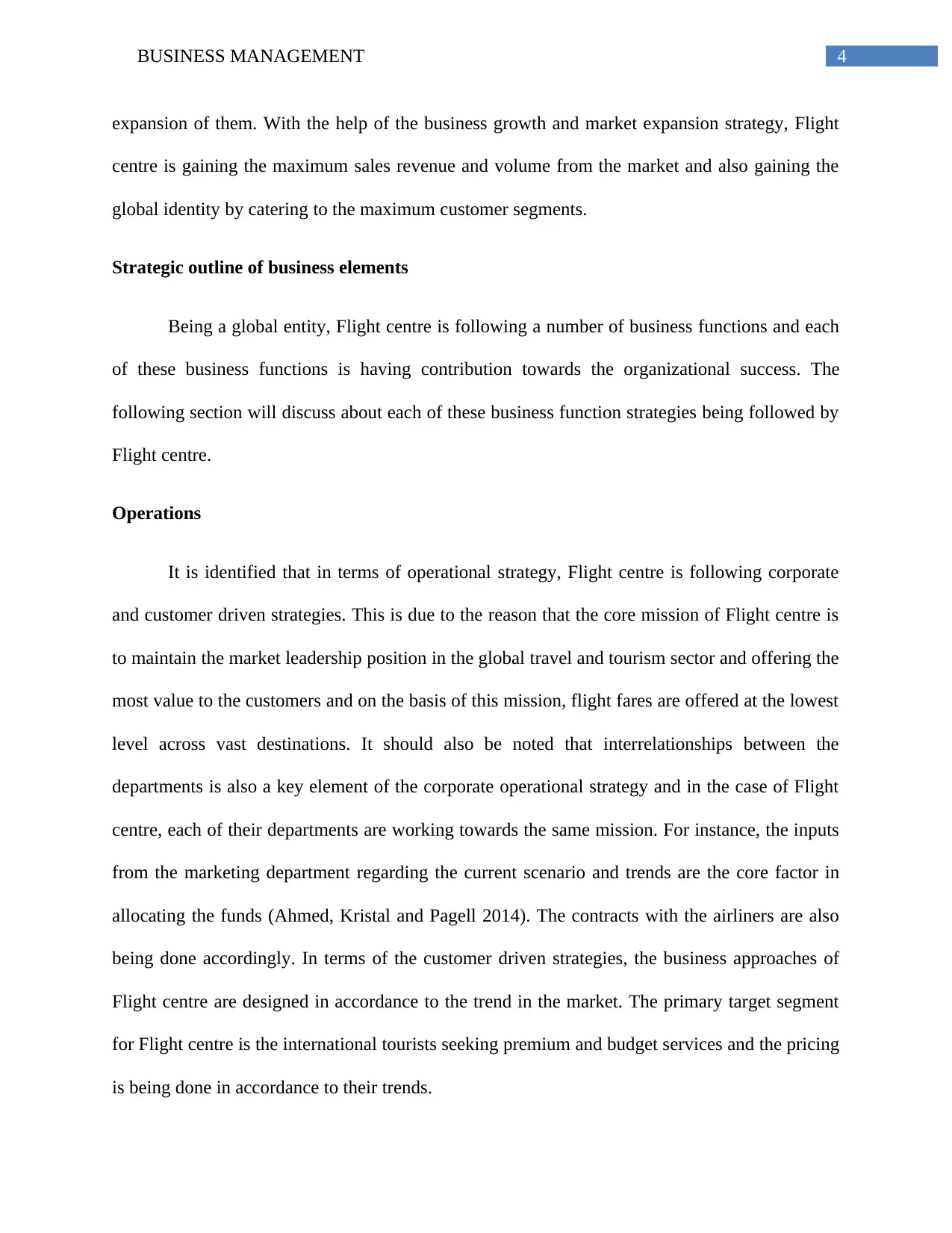
4BUSINESS MANAGEMENT
expansion of them. With the help of the business growth and market expansion strategy, Flight
centre is gaining the maximum sales revenue and volume from the market and also gaining the
global identity by catering to the maximum customer segments.
Strategic outline of business elements
Being a global entity, Flight centre is following a number of business functions and each
of these business functions is having contribution towards the organizational success. The
following section will discuss about each of these business function strategies being followed by
Flight centre.
Operations
It is identified that in terms of operational strategy, Flight centre is following corporate
and customer driven strategies. This is due to the reason that the core mission of Flight centre is
to maintain the market leadership position in the global travel and tourism sector and offering the
most value to the customers and on the basis of this mission, flight fares are offered at the lowest
level across vast destinations. It should also be noted that interrelationships between the
departments is also a key element of the corporate operational strategy and in the case of Flight
centre, each of their departments are working towards the same mission. For instance, the inputs
from the marketing department regarding the current scenario and trends are the core factor in
allocating the funds (Ahmed, Kristal and Pagell 2014). The contracts with the airliners are also
being done accordingly. In terms of the customer driven strategies, the business approaches of
Flight centre are designed in accordance to the trend in the market. The primary target segment
for Flight centre is the international tourists seeking premium and budget services and the pricing
is being done in accordance to their trends.
expansion of them. With the help of the business growth and market expansion strategy, Flight
centre is gaining the maximum sales revenue and volume from the market and also gaining the
global identity by catering to the maximum customer segments.
Strategic outline of business elements
Being a global entity, Flight centre is following a number of business functions and each
of these business functions is having contribution towards the organizational success. The
following section will discuss about each of these business function strategies being followed by
Flight centre.
Operations
It is identified that in terms of operational strategy, Flight centre is following corporate
and customer driven strategies. This is due to the reason that the core mission of Flight centre is
to maintain the market leadership position in the global travel and tourism sector and offering the
most value to the customers and on the basis of this mission, flight fares are offered at the lowest
level across vast destinations. It should also be noted that interrelationships between the
departments is also a key element of the corporate operational strategy and in the case of Flight
centre, each of their departments are working towards the same mission. For instance, the inputs
from the marketing department regarding the current scenario and trends are the core factor in
allocating the funds (Ahmed, Kristal and Pagell 2014). The contracts with the airliners are also
being done accordingly. In terms of the customer driven strategies, the business approaches of
Flight centre are designed in accordance to the trend in the market. The primary target segment
for Flight centre is the international tourists seeking premium and budget services and the pricing
is being done in accordance to their trends.
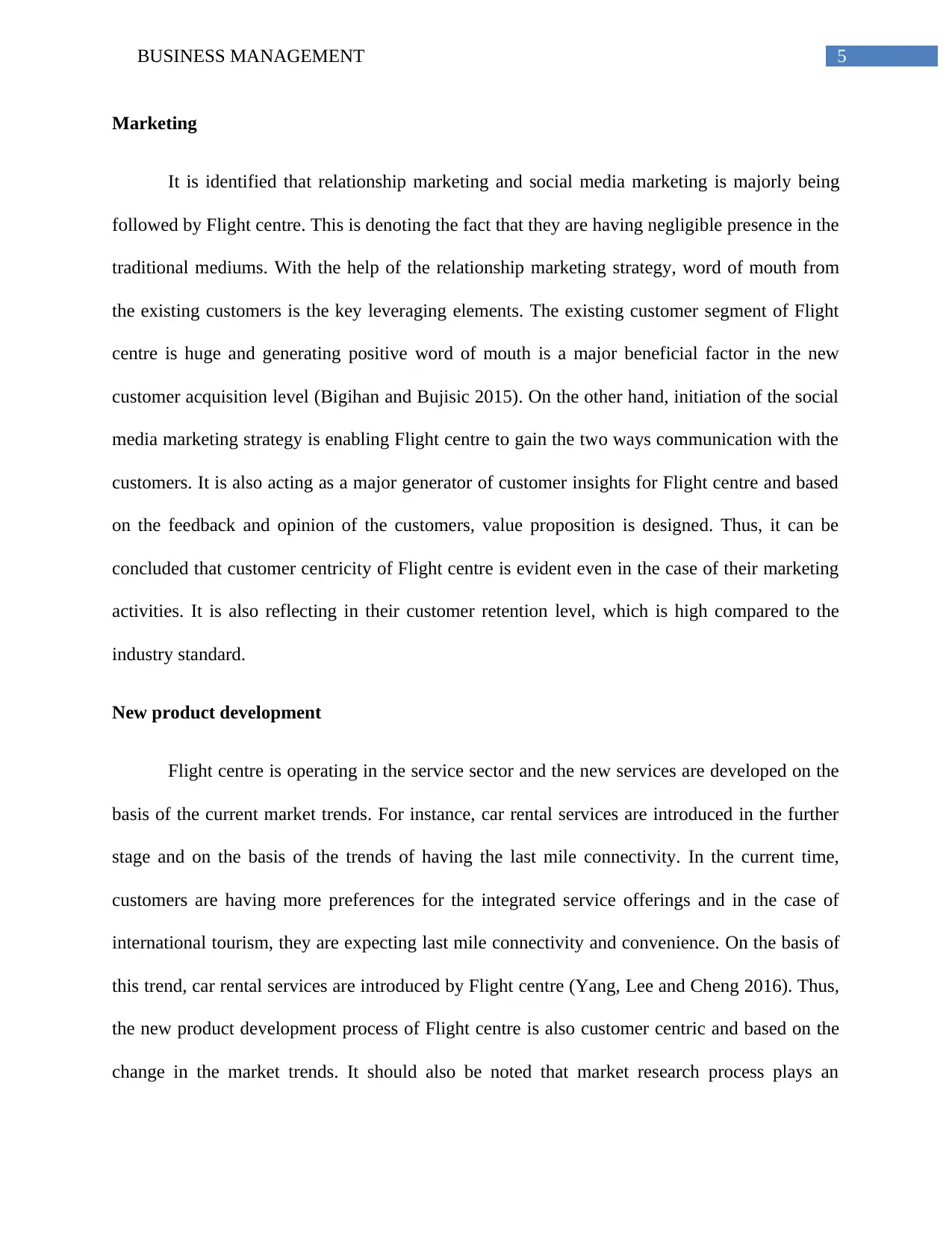
5BUSINESS MANAGEMENT
Marketing
It is identified that relationship marketing and social media marketing is majorly being
followed by Flight centre. This is denoting the fact that they are having negligible presence in the
traditional mediums. With the help of the relationship marketing strategy, word of mouth from
the existing customers is the key leveraging elements. The existing customer segment of Flight
centre is huge and generating positive word of mouth is a major beneficial factor in the new
customer acquisition level (Bigihan and Bujisic 2015). On the other hand, initiation of the social
media marketing strategy is enabling Flight centre to gain the two ways communication with the
customers. It is also acting as a major generator of customer insights for Flight centre and based
on the feedback and opinion of the customers, value proposition is designed. Thus, it can be
concluded that customer centricity of Flight centre is evident even in the case of their marketing
activities. It is also reflecting in their customer retention level, which is high compared to the
industry standard.
New product development
Flight centre is operating in the service sector and the new services are developed on the
basis of the current market trends. For instance, car rental services are introduced in the further
stage and on the basis of the trends of having the last mile connectivity. In the current time,
customers are having more preferences for the integrated service offerings and in the case of
international tourism, they are expecting last mile connectivity and convenience. On the basis of
this trend, car rental services are introduced by Flight centre (Yang, Lee and Cheng 2016). Thus,
the new product development process of Flight centre is also customer centric and based on the
change in the market trends. It should also be noted that market research process plays an
Marketing
It is identified that relationship marketing and social media marketing is majorly being
followed by Flight centre. This is denoting the fact that they are having negligible presence in the
traditional mediums. With the help of the relationship marketing strategy, word of mouth from
the existing customers is the key leveraging elements. The existing customer segment of Flight
centre is huge and generating positive word of mouth is a major beneficial factor in the new
customer acquisition level (Bigihan and Bujisic 2015). On the other hand, initiation of the social
media marketing strategy is enabling Flight centre to gain the two ways communication with the
customers. It is also acting as a major generator of customer insights for Flight centre and based
on the feedback and opinion of the customers, value proposition is designed. Thus, it can be
concluded that customer centricity of Flight centre is evident even in the case of their marketing
activities. It is also reflecting in their customer retention level, which is high compared to the
industry standard.
New product development
Flight centre is operating in the service sector and the new services are developed on the
basis of the current market trends. For instance, car rental services are introduced in the further
stage and on the basis of the trends of having the last mile connectivity. In the current time,
customers are having more preferences for the integrated service offerings and in the case of
international tourism, they are expecting last mile connectivity and convenience. On the basis of
this trend, car rental services are introduced by Flight centre (Yang, Lee and Cheng 2016). Thus,
the new product development process of Flight centre is also customer centric and based on the
change in the market trends. It should also be noted that market research process plays an
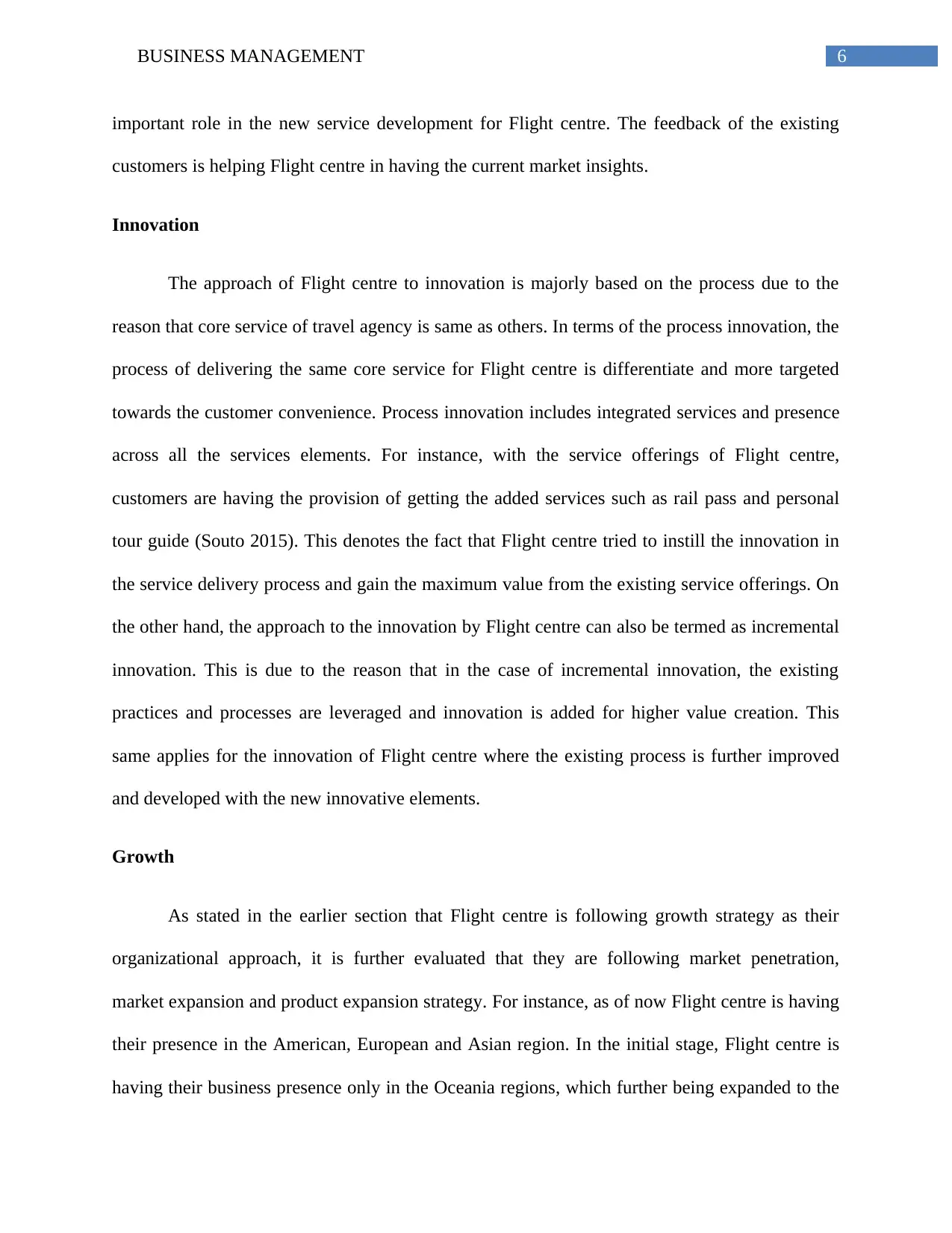
6BUSINESS MANAGEMENT
important role in the new service development for Flight centre. The feedback of the existing
customers is helping Flight centre in having the current market insights.
Innovation
The approach of Flight centre to innovation is majorly based on the process due to the
reason that core service of travel agency is same as others. In terms of the process innovation, the
process of delivering the same core service for Flight centre is differentiate and more targeted
towards the customer convenience. Process innovation includes integrated services and presence
across all the services elements. For instance, with the service offerings of Flight centre,
customers are having the provision of getting the added services such as rail pass and personal
tour guide (Souto 2015). This denotes the fact that Flight centre tried to instill the innovation in
the service delivery process and gain the maximum value from the existing service offerings. On
the other hand, the approach to the innovation by Flight centre can also be termed as incremental
innovation. This is due to the reason that in the case of incremental innovation, the existing
practices and processes are leveraged and innovation is added for higher value creation. This
same applies for the innovation of Flight centre where the existing process is further improved
and developed with the new innovative elements.
Growth
As stated in the earlier section that Flight centre is following growth strategy as their
organizational approach, it is further evaluated that they are following market penetration,
market expansion and product expansion strategy. For instance, as of now Flight centre is having
their presence in the American, European and Asian region. In the initial stage, Flight centre is
having their business presence only in the Oceania regions, which further being expanded to the
important role in the new service development for Flight centre. The feedback of the existing
customers is helping Flight centre in having the current market insights.
Innovation
The approach of Flight centre to innovation is majorly based on the process due to the
reason that core service of travel agency is same as others. In terms of the process innovation, the
process of delivering the same core service for Flight centre is differentiate and more targeted
towards the customer convenience. Process innovation includes integrated services and presence
across all the services elements. For instance, with the service offerings of Flight centre,
customers are having the provision of getting the added services such as rail pass and personal
tour guide (Souto 2015). This denotes the fact that Flight centre tried to instill the innovation in
the service delivery process and gain the maximum value from the existing service offerings. On
the other hand, the approach to the innovation by Flight centre can also be termed as incremental
innovation. This is due to the reason that in the case of incremental innovation, the existing
practices and processes are leveraged and innovation is added for higher value creation. This
same applies for the innovation of Flight centre where the existing process is further improved
and developed with the new innovative elements.
Growth
As stated in the earlier section that Flight centre is following growth strategy as their
organizational approach, it is further evaluated that they are following market penetration,
market expansion and product expansion strategy. For instance, as of now Flight centre is having
their presence in the American, European and Asian region. In the initial stage, Flight centre is
having their business presence only in the Oceania regions, which further being expanded to the
Paraphrase This Document
Need a fresh take? Get an instant paraphrase of this document with our AI Paraphraser
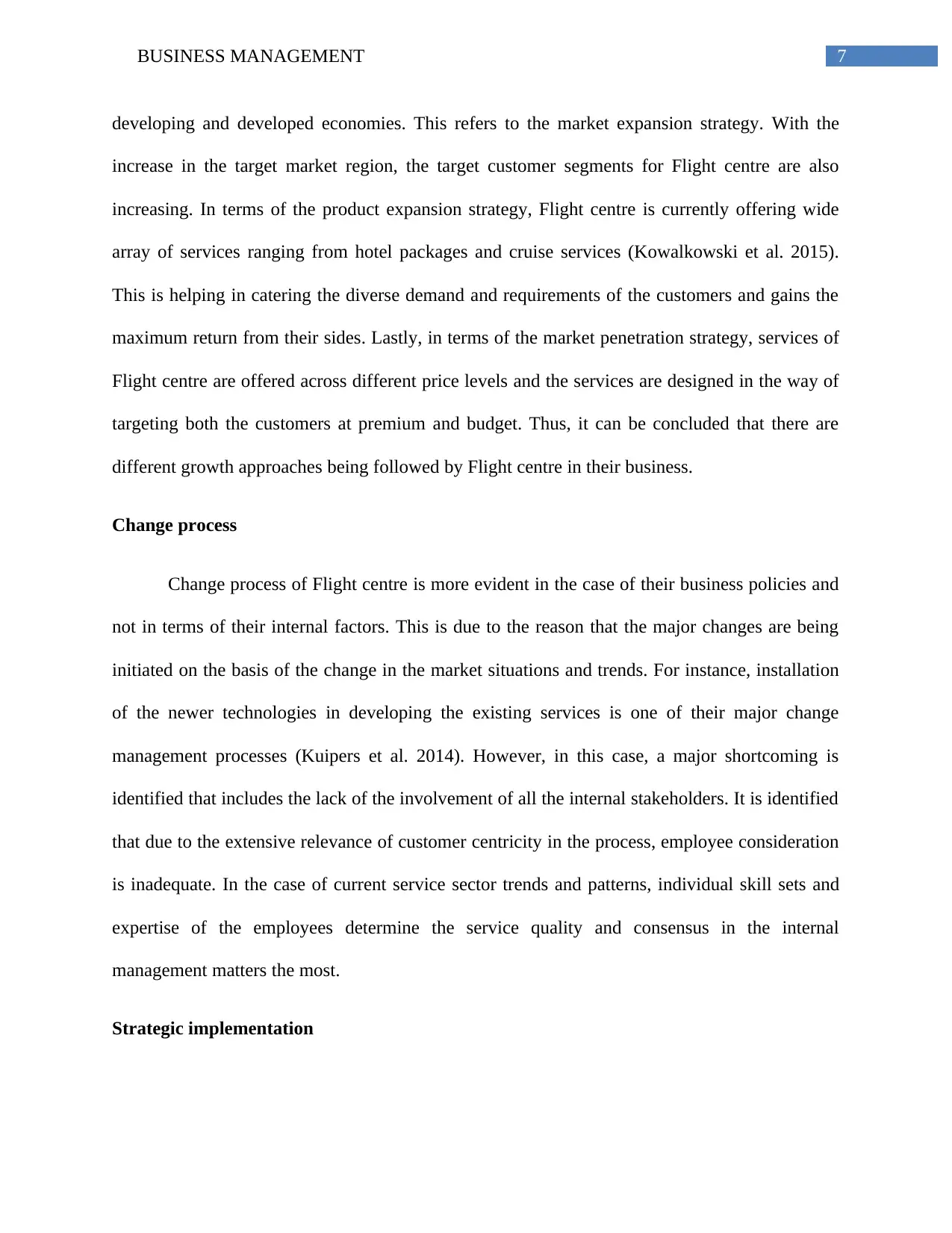
7BUSINESS MANAGEMENT
developing and developed economies. This refers to the market expansion strategy. With the
increase in the target market region, the target customer segments for Flight centre are also
increasing. In terms of the product expansion strategy, Flight centre is currently offering wide
array of services ranging from hotel packages and cruise services (Kowalkowski et al. 2015).
This is helping in catering the diverse demand and requirements of the customers and gains the
maximum return from their sides. Lastly, in terms of the market penetration strategy, services of
Flight centre are offered across different price levels and the services are designed in the way of
targeting both the customers at premium and budget. Thus, it can be concluded that there are
different growth approaches being followed by Flight centre in their business.
Change process
Change process of Flight centre is more evident in the case of their business policies and
not in terms of their internal factors. This is due to the reason that the major changes are being
initiated on the basis of the change in the market situations and trends. For instance, installation
of the newer technologies in developing the existing services is one of their major change
management processes (Kuipers et al. 2014). However, in this case, a major shortcoming is
identified that includes the lack of the involvement of all the internal stakeholders. It is identified
that due to the extensive relevance of customer centricity in the process, employee consideration
is inadequate. In the case of current service sector trends and patterns, individual skill sets and
expertise of the employees determine the service quality and consensus in the internal
management matters the most.
Strategic implementation
developing and developed economies. This refers to the market expansion strategy. With the
increase in the target market region, the target customer segments for Flight centre are also
increasing. In terms of the product expansion strategy, Flight centre is currently offering wide
array of services ranging from hotel packages and cruise services (Kowalkowski et al. 2015).
This is helping in catering the diverse demand and requirements of the customers and gains the
maximum return from their sides. Lastly, in terms of the market penetration strategy, services of
Flight centre are offered across different price levels and the services are designed in the way of
targeting both the customers at premium and budget. Thus, it can be concluded that there are
different growth approaches being followed by Flight centre in their business.
Change process
Change process of Flight centre is more evident in the case of their business policies and
not in terms of their internal factors. This is due to the reason that the major changes are being
initiated on the basis of the change in the market situations and trends. For instance, installation
of the newer technologies in developing the existing services is one of their major change
management processes (Kuipers et al. 2014). However, in this case, a major shortcoming is
identified that includes the lack of the involvement of all the internal stakeholders. It is identified
that due to the extensive relevance of customer centricity in the process, employee consideration
is inadequate. In the case of current service sector trends and patterns, individual skill sets and
expertise of the employees determine the service quality and consensus in the internal
management matters the most.
Strategic implementation
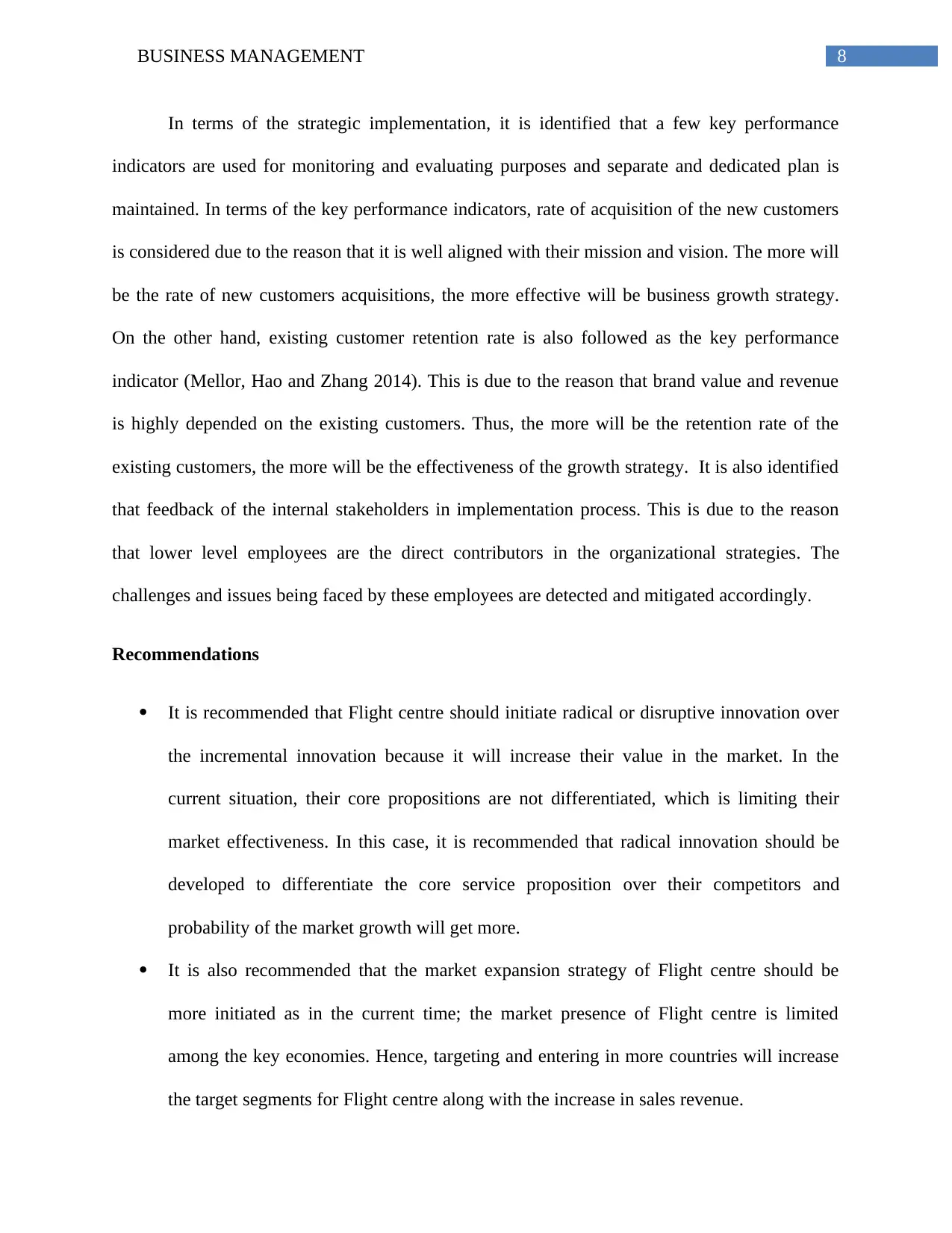
8BUSINESS MANAGEMENT
In terms of the strategic implementation, it is identified that a few key performance
indicators are used for monitoring and evaluating purposes and separate and dedicated plan is
maintained. In terms of the key performance indicators, rate of acquisition of the new customers
is considered due to the reason that it is well aligned with their mission and vision. The more will
be the rate of new customers acquisitions, the more effective will be business growth strategy.
On the other hand, existing customer retention rate is also followed as the key performance
indicator (Mellor, Hao and Zhang 2014). This is due to the reason that brand value and revenue
is highly depended on the existing customers. Thus, the more will be the retention rate of the
existing customers, the more will be the effectiveness of the growth strategy. It is also identified
that feedback of the internal stakeholders in implementation process. This is due to the reason
that lower level employees are the direct contributors in the organizational strategies. The
challenges and issues being faced by these employees are detected and mitigated accordingly.
Recommendations
It is recommended that Flight centre should initiate radical or disruptive innovation over
the incremental innovation because it will increase their value in the market. In the
current situation, their core propositions are not differentiated, which is limiting their
market effectiveness. In this case, it is recommended that radical innovation should be
developed to differentiate the core service proposition over their competitors and
probability of the market growth will get more.
It is also recommended that the market expansion strategy of Flight centre should be
more initiated as in the current time; the market presence of Flight centre is limited
among the key economies. Hence, targeting and entering in more countries will increase
the target segments for Flight centre along with the increase in sales revenue.
In terms of the strategic implementation, it is identified that a few key performance
indicators are used for monitoring and evaluating purposes and separate and dedicated plan is
maintained. In terms of the key performance indicators, rate of acquisition of the new customers
is considered due to the reason that it is well aligned with their mission and vision. The more will
be the rate of new customers acquisitions, the more effective will be business growth strategy.
On the other hand, existing customer retention rate is also followed as the key performance
indicator (Mellor, Hao and Zhang 2014). This is due to the reason that brand value and revenue
is highly depended on the existing customers. Thus, the more will be the retention rate of the
existing customers, the more will be the effectiveness of the growth strategy. It is also identified
that feedback of the internal stakeholders in implementation process. This is due to the reason
that lower level employees are the direct contributors in the organizational strategies. The
challenges and issues being faced by these employees are detected and mitigated accordingly.
Recommendations
It is recommended that Flight centre should initiate radical or disruptive innovation over
the incremental innovation because it will increase their value in the market. In the
current situation, their core propositions are not differentiated, which is limiting their
market effectiveness. In this case, it is recommended that radical innovation should be
developed to differentiate the core service proposition over their competitors and
probability of the market growth will get more.
It is also recommended that the market expansion strategy of Flight centre should be
more initiated as in the current time; the market presence of Flight centre is limited
among the key economies. Hence, targeting and entering in more countries will increase
the target segments for Flight centre along with the increase in sales revenue.
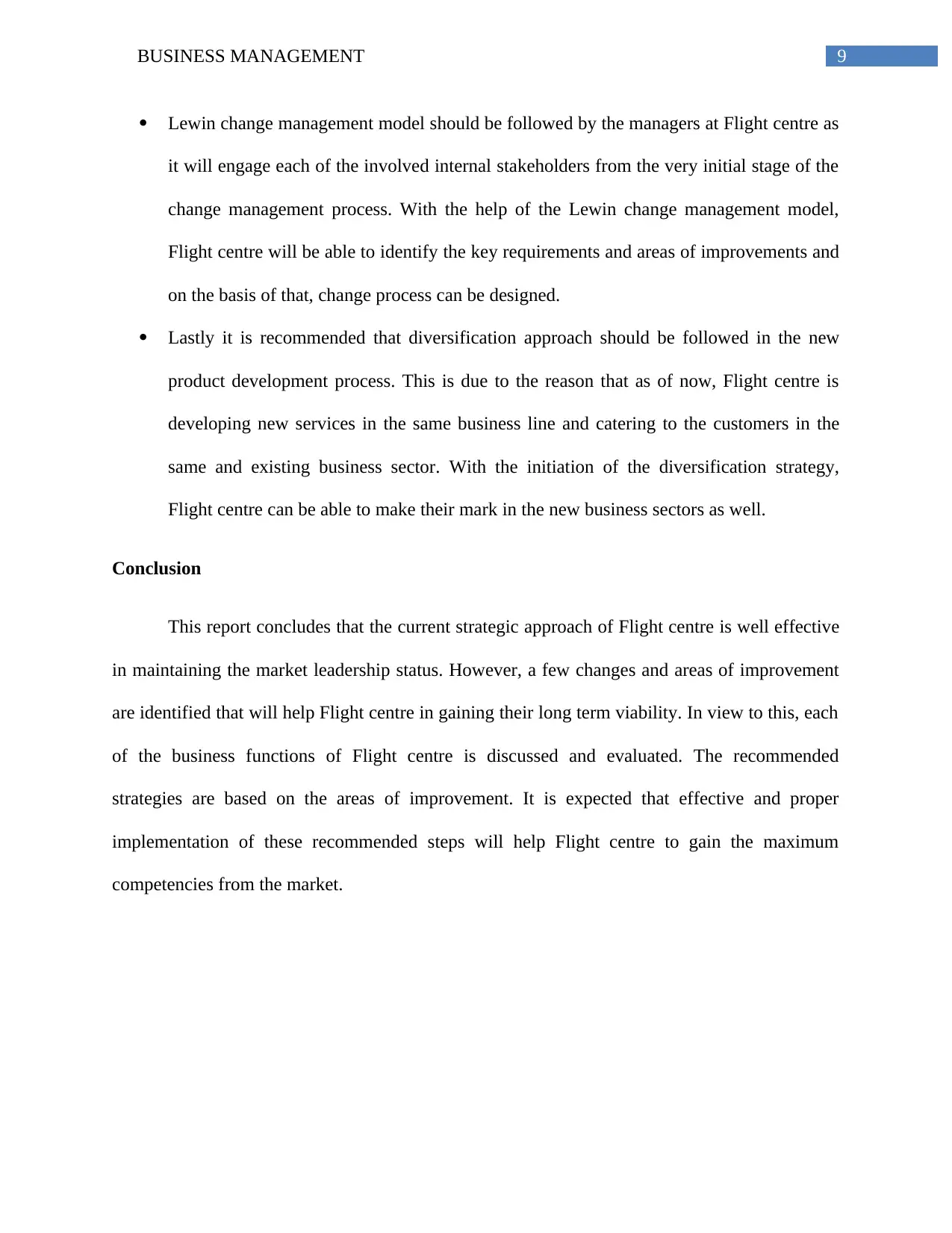
9BUSINESS MANAGEMENT
Lewin change management model should be followed by the managers at Flight centre as
it will engage each of the involved internal stakeholders from the very initial stage of the
change management process. With the help of the Lewin change management model,
Flight centre will be able to identify the key requirements and areas of improvements and
on the basis of that, change process can be designed.
Lastly it is recommended that diversification approach should be followed in the new
product development process. This is due to the reason that as of now, Flight centre is
developing new services in the same business line and catering to the customers in the
same and existing business sector. With the initiation of the diversification strategy,
Flight centre can be able to make their mark in the new business sectors as well.
Conclusion
This report concludes that the current strategic approach of Flight centre is well effective
in maintaining the market leadership status. However, a few changes and areas of improvement
are identified that will help Flight centre in gaining their long term viability. In view to this, each
of the business functions of Flight centre is discussed and evaluated. The recommended
strategies are based on the areas of improvement. It is expected that effective and proper
implementation of these recommended steps will help Flight centre to gain the maximum
competencies from the market.
Lewin change management model should be followed by the managers at Flight centre as
it will engage each of the involved internal stakeholders from the very initial stage of the
change management process. With the help of the Lewin change management model,
Flight centre will be able to identify the key requirements and areas of improvements and
on the basis of that, change process can be designed.
Lastly it is recommended that diversification approach should be followed in the new
product development process. This is due to the reason that as of now, Flight centre is
developing new services in the same business line and catering to the customers in the
same and existing business sector. With the initiation of the diversification strategy,
Flight centre can be able to make their mark in the new business sectors as well.
Conclusion
This report concludes that the current strategic approach of Flight centre is well effective
in maintaining the market leadership status. However, a few changes and areas of improvement
are identified that will help Flight centre in gaining their long term viability. In view to this, each
of the business functions of Flight centre is discussed and evaluated. The recommended
strategies are based on the areas of improvement. It is expected that effective and proper
implementation of these recommended steps will help Flight centre to gain the maximum
competencies from the market.
Secure Best Marks with AI Grader
Need help grading? Try our AI Grader for instant feedback on your assignments.
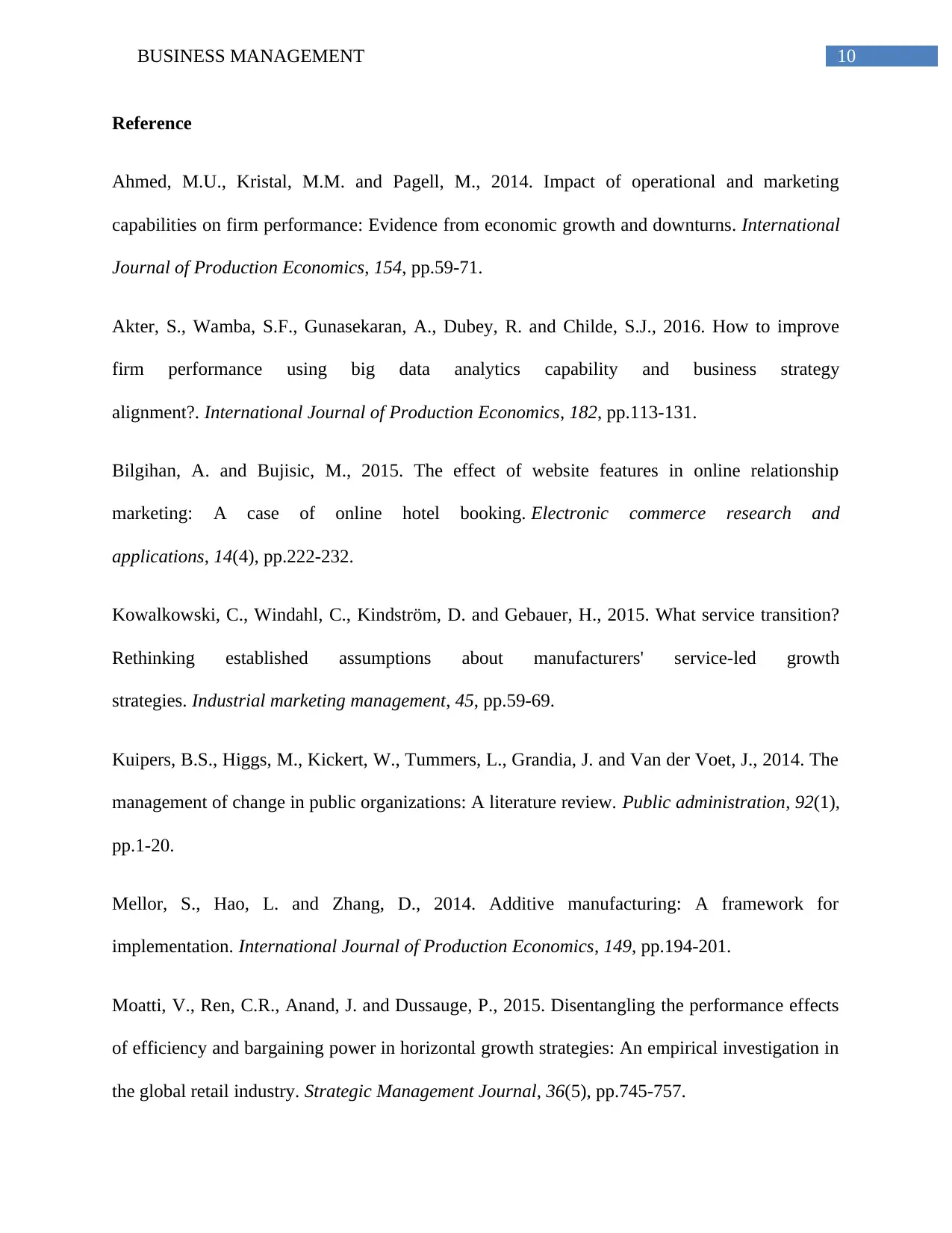
10BUSINESS MANAGEMENT
Reference
Ahmed, M.U., Kristal, M.M. and Pagell, M., 2014. Impact of operational and marketing
capabilities on firm performance: Evidence from economic growth and downturns. International
Journal of Production Economics, 154, pp.59-71.
Akter, S., Wamba, S.F., Gunasekaran, A., Dubey, R. and Childe, S.J., 2016. How to improve
firm performance using big data analytics capability and business strategy
alignment?. International Journal of Production Economics, 182, pp.113-131.
Bilgihan, A. and Bujisic, M., 2015. The effect of website features in online relationship
marketing: A case of online hotel booking. Electronic commerce research and
applications, 14(4), pp.222-232.
Kowalkowski, C., Windahl, C., Kindström, D. and Gebauer, H., 2015. What service transition?
Rethinking established assumptions about manufacturers' service-led growth
strategies. Industrial marketing management, 45, pp.59-69.
Kuipers, B.S., Higgs, M., Kickert, W., Tummers, L., Grandia, J. and Van der Voet, J., 2014. The
management of change in public organizations: A literature review. Public administration, 92(1),
pp.1-20.
Mellor, S., Hao, L. and Zhang, D., 2014. Additive manufacturing: A framework for
implementation. International Journal of Production Economics, 149, pp.194-201.
Moatti, V., Ren, C.R., Anand, J. and Dussauge, P., 2015. Disentangling the performance effects
of efficiency and bargaining power in horizontal growth strategies: An empirical investigation in
the global retail industry. Strategic Management Journal, 36(5), pp.745-757.
Reference
Ahmed, M.U., Kristal, M.M. and Pagell, M., 2014. Impact of operational and marketing
capabilities on firm performance: Evidence from economic growth and downturns. International
Journal of Production Economics, 154, pp.59-71.
Akter, S., Wamba, S.F., Gunasekaran, A., Dubey, R. and Childe, S.J., 2016. How to improve
firm performance using big data analytics capability and business strategy
alignment?. International Journal of Production Economics, 182, pp.113-131.
Bilgihan, A. and Bujisic, M., 2015. The effect of website features in online relationship
marketing: A case of online hotel booking. Electronic commerce research and
applications, 14(4), pp.222-232.
Kowalkowski, C., Windahl, C., Kindström, D. and Gebauer, H., 2015. What service transition?
Rethinking established assumptions about manufacturers' service-led growth
strategies. Industrial marketing management, 45, pp.59-69.
Kuipers, B.S., Higgs, M., Kickert, W., Tummers, L., Grandia, J. and Van der Voet, J., 2014. The
management of change in public organizations: A literature review. Public administration, 92(1),
pp.1-20.
Mellor, S., Hao, L. and Zhang, D., 2014. Additive manufacturing: A framework for
implementation. International Journal of Production Economics, 149, pp.194-201.
Moatti, V., Ren, C.R., Anand, J. and Dussauge, P., 2015. Disentangling the performance effects
of efficiency and bargaining power in horizontal growth strategies: An empirical investigation in
the global retail industry. Strategic Management Journal, 36(5), pp.745-757.
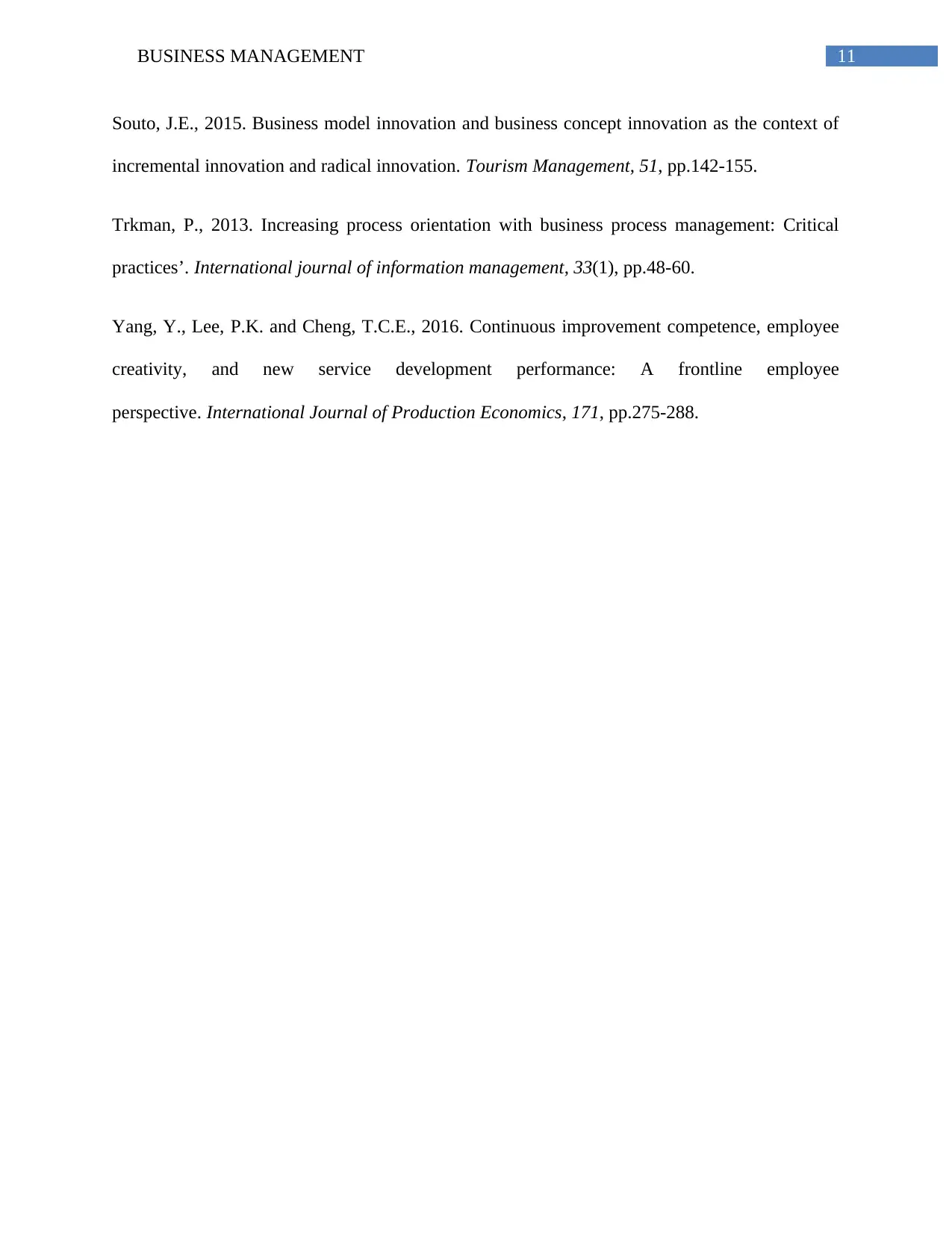
11BUSINESS MANAGEMENT
Souto, J.E., 2015. Business model innovation and business concept innovation as the context of
incremental innovation and radical innovation. Tourism Management, 51, pp.142-155.
Trkman, P., 2013. Increasing process orientation with business process management: Critical
practices’. International journal of information management, 33(1), pp.48-60.
Yang, Y., Lee, P.K. and Cheng, T.C.E., 2016. Continuous improvement competence, employee
creativity, and new service development performance: A frontline employee
perspective. International Journal of Production Economics, 171, pp.275-288.
Souto, J.E., 2015. Business model innovation and business concept innovation as the context of
incremental innovation and radical innovation. Tourism Management, 51, pp.142-155.
Trkman, P., 2013. Increasing process orientation with business process management: Critical
practices’. International journal of information management, 33(1), pp.48-60.
Yang, Y., Lee, P.K. and Cheng, T.C.E., 2016. Continuous improvement competence, employee
creativity, and new service development performance: A frontline employee
perspective. International Journal of Production Economics, 171, pp.275-288.
1 out of 12
Related Documents
Your All-in-One AI-Powered Toolkit for Academic Success.
+13062052269
info@desklib.com
Available 24*7 on WhatsApp / Email
![[object Object]](/_next/static/media/star-bottom.7253800d.svg)
Unlock your academic potential
© 2024 | Zucol Services PVT LTD | All rights reserved.




